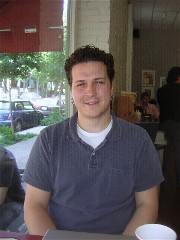
James Johnson, the chairman of a new department in photography and digital arts at Moore College of Art and Design
James Johnson, the photographic installation artist who makes peepholes into “rooms” behind walls and inside boxes is setting up a new Photography and Digital Arts department at Moore College of Art and Design(see posts about Johnson’s work here, here and here,). As a self-described photo-weenie (“Maybe because I went to RIT,” he said) he’s bringing cutting-edge technology galore to the program.
This new department chair’s ambition and vision for the program–as well as the amount of funds Moore is sinking into it–are enormous. He gave me the initial news blast back at Zoe Strauss’ 2006 extravaganza under I-95, and he said something about all the interesting directions that contemporary photography is moving, so I wanted to hear more. I got back to him a few weeks later at the Green Line Cafe.
For the past year, Johnson, who comes from Delhi, New York, taught at Bucknell, with all the equipment and resources he needed: “They give you all these resources–Wacom tablets [USB drawing tablets],” he said. “I use them to build those photos to go in boxes in Photoshop. I called up the IT department for one to use as a demo, and they called back that they were just going to buy 20 of them!”
The specs at Moore
Moore College is more than measuring up to Bucknell’s level: “I have to make this major top notch. Hopefully the labs Moore is starting up will be the envy of all the schools on the East Coast.” For digital media, Moore is building a whole new lab with 15 computers–the fastest professional Apples (well, almost–the day they arrived, Apple announced an even faster model). A high-end printing and scanning center will include two 44″ wide inkjet printers, one for matte paper, one for glossy. They will also have a “fancy” film scanner for scanning large-format negatives and chromes.
But the program will also include traditional photography, film developing and making prints. The school will buy film cameras as well as some 13 megapixel higher end DSLRs. There will be an alternate processes facility (i.e. to develop anything that is non-silver and non-digital), and a history of photography course.
The push to digital reflects all the changes that are happening in photography. “Photographs are becoming a lot more like paintings because of what Photoshop allows you to do. …For instance, if I take a photograph of your face, if I wanted to brighten a spot, or change the blue on your glasses to another color, I could do that [in Photoshop].”
Photos and truth
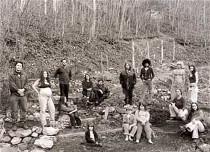
Wood Song, by Justine Kurland, 2002, Toned gelatin silver print, 14 1/4 x 18”
I asked him where he thought photography was going.
The Cartier-Bresson concept of the decisive moment is no longer an issue, said Johnson. “Until the early ’90s, when Photoshop became viable, photography was about truth–about what happened before the camera. But now with Photoshop, you can make all kinds of things look like the truth. My students already are skeptical about the veracity of a photograph.”
He told the story of a friend who got a nasty surprise–a parking ticket that he didn’t think he deserved. Sure enough, when he walked around the car to the curb, he saw the top of a hydrant poking through some really deep snow. So he took a bunch of photos and then, using Photoshop, completely buried the hydrant beneath a snow bank. He printed out a digital C-print, and convinced the judge that he didn’t deserve the ticket. “So that’s what you can do with Photoshop.
“I think it gives us more control over how we write the narrative of our lives. At this point, you can spin anything however you want to.”
A different perspective
Johnson started talking about the David Hockney book, “Secret Knowledge,” about how the discovery of lenses influenced painting.
But then he went on to say with Photoshop, the tyranny of one-point perspective of the photograph no longer was an issue. “Now photographs are starting to fall apart. Now you can make a De Chirico kind of photograph with perspective going the wrong way. …I just hope it doesn’t become too cliche to quickly.”
He started mentioning contemporary photographers whose work he admired, like the work of Loretta Lux, whose photographs of children dressed up in thrift-store-acquired clothing, posed in front of manipulated backdrops, are weird and creepy and interesting.
I couldn’t place Lux, so he brought out his laptop, a MacBook Pro, 1.83 dual core Intel processor with 1 G of ram and a 100 G hard drive, which he got for the job. I got a slide show of her work.
“I like things that are connected to art history,” and for staying power, he said, work needs to be in conversation with work of the past and what’s happening in the present.
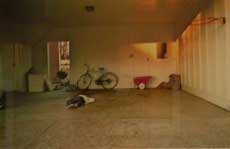
by William Eggleston
He said he was also interested in photographs of deadpan objects, as in the work of William Eggleston, the Berndt and Hilla Becher and their progeny, like Andreas Gursky.
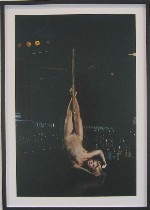
A pole dancer photo by Philip-Lorca di Corcia
Invented melodrama, as in the work of Anna Gaskell and Philip-Lorca di Corcia, is also a strong stream in contemporary photography.
Also in this category, Johnson mentioned the work of Stephen Shore, and talked about Gregory Crewdson, who uses a 1950s Americana aesthetic of idealized trailer parks and automobiles–“vernacular-looking places all built on a sound stage.” Johnson said Crewdson has make-up people, uses famous actors like William H. Macy and Julianne Moore, and even has a photographer who actually snaps the pictures. Crewdson’s influence as a teacher at Yale has influenced the work of a number of young photographers, including Justine Kurland, Katie Grannan and Gaskell.
Johnson said he’d like to see more cutting-edge work displayed in Philadelphia, like the photo installations of Christian Boltanski, and video.
Video specs
Speaking of video, he said that the equipment in video is exclusively high definition, preparing for the future when all broadcasting by tv stations will be required to be HD. He said Karen Lefkowitz, who established video at Moore, will be teaching the video classes, and the classes will be using Final Cut Pro for editing.
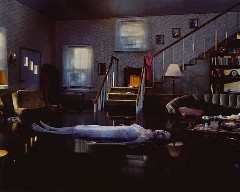
Untitled (Ophelia), by Gregory Crewdson, 2001, digital C-print, 48 x 60 inches
I asked Johnson if he had any shows coming up, and he mintioned, among other things, that he will be participating in Subterrane, an internet-only show curated by former Asian Arts Inititative gallery coordinator Sean Stoops that will be up in August and September. Johnson added that the exhibit will then be adapated for a real-world showing at the Center for Emerging Visual Artists.
But at this moment, he was totally excited about what he could do at Moore College. He said he admired how so many wonderful photographers came out of Yale, thanks to Crewdson’s influence. “Maybe I’ll do that at Moore–set the bar high for myself.”









